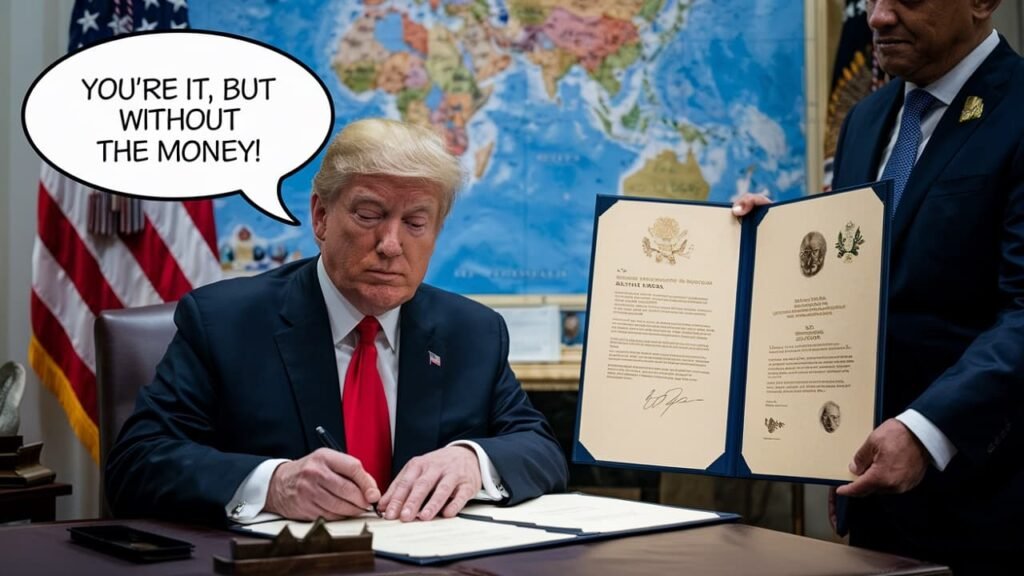Buckle up, America—your car loan might just get a tax-break joyride! President Donald Trump’s shiny new tax law, signed with a flourish on July 4, 2025, lets you deduct up to $10,000 a year in auto loan interest, but only if your vehicle rolled off a U.S. assembly line. This isn’t a free-for-all, though—there’s a roadmap of rules to navigate, and not every driver will make the cut.
Let’s start with the basics: the deduction applies to new vehicles only, so your trusty 2015 sedan won’t qualify. We’re talking cars, SUVs, minivans, pickup trucks, and motorcycles, as long as they weigh less than 14,000 pounds and aren’t used for business or fleet purposes. The catch? Your ride must be assembled in the U.S., which is trickier than it sounds—more on that later.
Trump first revved up this idea during his 2024 campaign, promising it would make car ownership cheaper and spark a boom in American auto factories. Congress bought the pitch, baking it into the “One Big Beautiful Bill Act” (yes, that’s the real name). From 2025 to 2028, qualifying buyers can shave off some tax burden, but don’t expect a golden ticket if you’re rolling in dough—more on that, too.
So, who’s eligible? The deduction is open to anyone, even if you don’t itemize deductions, which is a rare treat in the tax world. However, if you’re a single filer earning over $100,000 or a joint filer over $200,000, the deduction shrinks by $200 for every $1,000 you earn above those thresholds. Cross $150,000 (or $250,000 for couples), and you’re out of luck entirely.

Now, let’s talk numbers. Last year, U.S. dealers sold 15.9 million new light vehicles, with about half built in the U.S., per Cox Automotive. Roughly 60% of those sales involved loans, so around 3.5 million buyers could potentially claim this break in 2025, assuming they stick to American-made models.
But here’s where it gets as confusing as a five-way intersection. The tax break hinges on where your vehicle’s final assembly happened, not where the company’s headquartered. Tesla’s a slam dunk—all its cars are U.S.-built. But Ford? Only 78% of its vehicles sold here last year were American-assembled. That Mustang you’re eyeing? Michigan-made. The Mustang Mach-E? Mexico, so no deduction for you.
General Motors is another mixed bag. Every Cadillac rolls off a U.S. line, but only 44% of Chevrolets and a measly 14% of Buicks qualify. Meanwhile, Japanese brands like Honda (60%), Toyota (52%), and Nissan (48%) often outdo GM in U.S. assembly rates, according to Cox Automotive. So, your “American” Chevy might leave you high and dry, while a Toyota RAV4 could be your tax-break bestie.
How much can you save? The average new vehicle loan is $44,000 over six years. At a 9.3% interest rate, you might pocket about $2,200 in federal tax savings over four years, says Jonathan Smoke, Cox Automotive’s chief economist. If you snag a 6.5% rate, the savings dip, but you’re still shaving hundreds off your tax bill.
Here’s a bonus: this deduction could trim your state taxes, too. Unlike home loan interest, which requires itemizing, this auto loan break is “above-the-line,” meaning it lowers your adjusted gross income before you even get to deductions. Since many states use your federal AGI to calculate their taxes, you might see extra savings at the state level.
But don’t start celebrating yet. This deduction only applies to loans taken out from 2025 to 2028, so if you bought your car last year, you’re stuck in neutral. And with interest payments frontloaded, your savings will shrink each year as you pay down the principal. Plus, you’ll need to report your vehicle’s VIN to prove it’s U.S.-assembled—dealers might help, but don’t count on them handing you a cheat sheet.
The IRS is expected to release a list of qualifying vehicles, similar to what they do for electric vehicle credits, but until then, buyers will need to do some homework. Not every model from a “U.S.” brand qualifies, and some foreign brands might surprise you. For example, Acura’s entire lineup is American-made, but your dream BMW? Check the VIN, because it might have been shipped from Germany.
Will this spark a car-buying frenzy? Smoke says it won’t likely sway many purchase decisions, as the savings—about $500 a year for most—aren’t game-changers. Plus, with tariffs potentially hiking vehicle prices, the deduction might just soften the blow rather than fuel a buying spree. Still, for the 3.5 million buyers who qualify, it’s a nice perk to offset those monthly payments.










